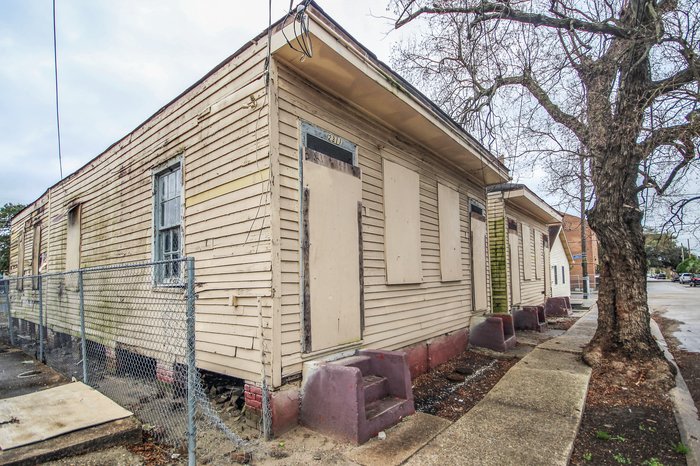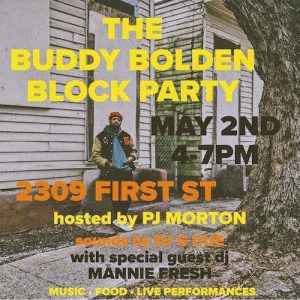
Musical pioneer Buddy Bolden’s former home on First and Lasalle streets. (courtesy of Preservation Resource Center)
By Emily Carmichael, emilycarmichael19@gmail.com
Musician PJ Morton had not heard of Buddy Bolden until three years ago, when the Greater St. Stephen Full Gospel Baptist Church, where his parents are pastors, planned to turn Bolden’s former Central City home into a parking lot.
The architect for the project, a longtime friend of Morton’s, sent him an article about Bolden, the cornetist considered the founding father of jazz. “[He] was like ‘Hey man your mom, they just tried to knock down Buddy Bolden’s house,’” Morton said. “And I’m like, ‘Who’s Buddy Bolden?’”
Now Morton has joined forces with the Preservation Resource Center and Marcelin Engineering to renovate the house as well as the identical house adjacent to it. Morton’s new non-profit, Buddy’s House Foundation, will operate the houses.

via instagram.com/pjmorton
On Thursday, Morton, a Grammy winner best known as the keyboardist for Maroon 5, hosted the Buddy Bolden Block Party to celebrate the reclamation of 2309 First St. after decades of anonymity and neglect.
The city’s Historic District Landmarks Commission had repeatedly cited the Greater St. Stephen, owners of the building and the twin shotgun next door, for demolition by neglect.
PJ Morton — the son of Greater St. Stephen pastors the Rev. Debra B. Morton and Bishop Paul S. Morton — said he wants to turn the buildings into a museum that honors Bolden’s legacy and a space to educate New Orleans musicians in the business of producing and licensing recordings.
When young Charles Joseph “Buddy” Bolden lived at the address around the turn of the 20th century, legend has it that his mother used to kick him out of the house for practicing his cornet too loudly. Bolden would go outside and play on the stoop, blowing the first notes of what would later evolve into jazz music.
“The fact that these houses are being brought back to life in a way that is historically respectful of what was there but also is going to be activated for the future … I can’t imagine a more beautiful blending of honoring history while moving something into the future,” PRC Executive Director Danielle Del Sol said.
The house today is unassuming, a beige double shotgun with light-blue painted plywood framing the doors and windows. There is still history to be salvaged, Del Sol said, in this house that fell into foggy oblivion after Bolden moved on from it, much like the musician himself.
Del Sol pointed out the outlines of cornices above the door that she said were stolen years ago, an architectural hint to what the home used to look like. Inside, the house has original fireplaces and mantels. Carbon dating can be used to peel back the layers of paint and pinpoint the exact color that graced the cypress and barge-board exterior of the home when Bolden lived in it.
Although dedicated jazz fans have long made pilgrimages to this site, most people in the neighborhood did not know who Bolden was or that they lived among his historic home.
Few pictures of Bolden survive today, and there are no known recordings of him playing. After a meteoric musical career that inspired the likes of Louis Armstrong, he ended up in the Louisiana State Insane Asylum, where he died in 1931.
With the Buddy’s House Foundation, Morton wants to not only restore the musical pioneer’s childhood home, but also his legacy.
Morton said he will develop the double shotgun into a “Past House” and a “Future House.” The Past House will include the the home where Bolden lived, turning it into a museum dedicated to his Bolden’s life and the impact of his music. The Future House will take the house next door and turn it into a recording studio.
He hopes the Future House in particular will work to empower local musicians with the savvy usually sequestered in big cities with big producers, like Chicago, Los Angeles and New York.
“In New Orleans, if you’re a musician, it’s like wearing a badge of honor,” Morton said. “But we want that badge of honor to also equate to comfort and living well financially, to be quite honest.”
In addition to the Buddy’s House Foundation, Morton has joined the New Orleans Music Economy initiative, a Greater New Orleans Inc. endeavor to foster the local music economy.
While the focus of Buddy’s House Foundation will, of course, be musical, Morton wants the house to serve as a broader source of creative inspiration for the children of Central City.
“What I love about music creation and creativity in general is you can be sitting in on a class about song writing and start thinking about some type of science that you want to do you … because its all creative in a sense,” Morton said. “You have to be creative to be successful in a way, to be a leader.”
Thursday’s block party set up a stage steps away from where the stoop where Bolden started and played music that, according to Morton, would not exist without him. Performances included DJ G CUE and Mannie Fresh. Morton himself performed with Bolden’s great grandson, Trombonist “Big Sam” Williams of Big Sam’s Funky Nation.
“Now that I know of his legacy, it’s touched me,” Morton said. “Because I feel like the seed that Buddy planted that started jazz, New Orleans jazz, didn’t just turn into the modern jazz that we know today. It turned into R&B music, which is me. It turned into Fats Domino and Allen Toussaint, and I’m the lineage of that. Although I didn’t know it, I’m part of Buddy’s legacy.”
Who will carry this mantel next? Buddy’s House Foundation’s mission, in part, is to find out. “There’s a Buddy Bolden in one of these homes,” Morton said. “We just may not know it yet.”